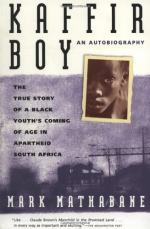|
This section contains 1,416 words (approx. 4 pages at 400 words per page) |

|
Carson is an instructor of English literature and composition. In this essay, Carson discusses Kaffir Boy in relation to both postcolonialism and other South African literary biographies.
Postcolonial studies and literary criticism examine twentieth century political and social issues resulting form interactions between European nations and the peoples they colonized. Of especial concern are humanitarian issues, particularly disparities in the treatment and living conditions between the native peoples and the colonizers who have raped the natural resources and wealth for themselves. Displacement and loss of traditional value systems and inequities in land ownership have created volatile, racial imbalance between the majority black populations and white minority legal structure. In South Africa, for instance, the Native Land Act of 1913 reserved only 13 percent of its land for Africans who made up 80 percent of the population. As more and more natives fled to cities like Johannesburg in search of jobs...
|
This section contains 1,416 words (approx. 4 pages at 400 words per page) |

|




